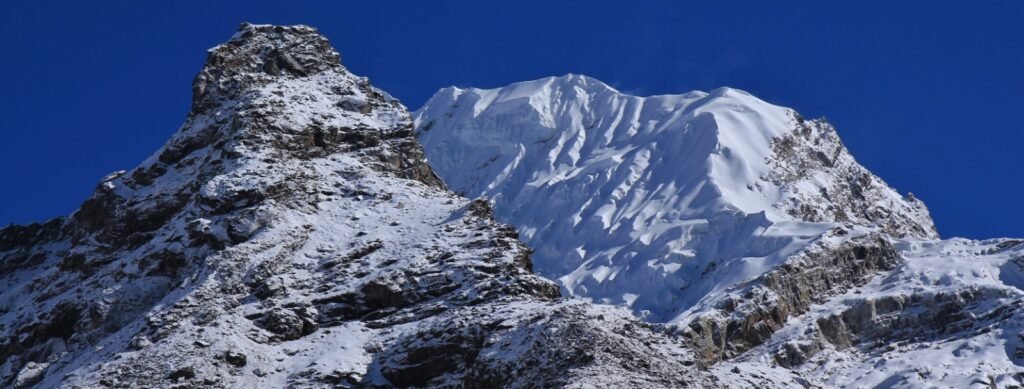Nestled within the majestic embrace of the Himalayan range, Lobuche Peak emerges as a thrilling challenge, inviting adventurers to partake in a mesmerizing ascent that transcends the ordinary. At an elevation of 6,119 meters (20,075 feet), this pyramid-shaped peak in the Everest region captivates mountaineers with its daunting silhouette and promises an extraordinary journey through the heart of the Himalayas. Lobuche Peak’s ascent is not merely a physical conquest but an immersive experience that demands both technical expertise and mental fortitude.

The climb involves navigating treacherous terrains, from the infamous Khumbu Glacier and Icefall to steep rock faces, all amidst the unparalleled beauty of the world’s highest peaks. This ascent represents more than reaching a summit; it symbolizes a profound connection with the Himalayan wilderness, cultural exploration in Sherpa villages, and a testament to the unwavering spirit of those who seek the thrill of conquering heights in one of the planet’s most awe-inspiring landscapes. Join us as we embark on an exploration of Lobuche Peak, where every step is an adventure and each vista tells a story of resilience and triumph in the heart of the Himalayas.
1. The Himalayan Majesty of Lobuche Peak
Lobuche Peak is a commanding presence in the Everest region, surrounded by some of the world’s highest peaks. Its pyramid shape and soaring elevation make it a striking feature in the Himalayan skyline. The journey to Lobuche is not only about reaching a summit but also about immersing oneself in the unparalleled beauty of the Himalayan range.
2. Preparation: Physically and Mentally
Preparing for the ascent of Lobuche Peak is a comprehensive process that demands both physical prowess and mental resilience. Climbers undergo rigorous training regimes to acclimatize to the high-altitude conditions. Cardiovascular conditioning, strength training, and altitude simulations are essential components of this preparation. Mental fortitude is equally crucial, as climbers gear up to face the technical challenges and unpredictable weather conditions that characterize the ascent.
3. Navigating the Khumbu Glacier and Icefall
The ascent of Lobuche often involves navigating through the infamous Khumbu Glacier and Icefall. These frozen landscapes present a labyrinth of crevasses and towering ice formations. Equipped with crampons and ice axes, climbers negotiate this icy terrain, adding an element of adventure and risk to the ascent. The Khumbu Glacier and Icefall are not merely obstacles to overcome but integral parts of the journey that showcase the raw beauty of the Himalayas.
4. Technical Climbing Challenges
Lobuche Peak isn’t just a high-altitude climb; it’s a technical masterpiece that challenges climbers with steep rock faces and icy slopes. Mastery of advanced mountaineering techniques is crucial as climbers ascend through sections that demand precise footwork and strategic use of equipment. The ascent becomes a dance between climber and mountain, a test of skill and endurance.
5. The Triumph of Reaching the Summit
Standing on the summit of Lobuche Peak is a moment of unparalleled triumph. The panoramic views from this lofty perch provide a breathtaking 360-degree perspective of the surrounding Himalayan giants. Everest, Lhotse, Nuptse, and Ama Dablam create a surreal backdrop, offering climbers not just a sense of accomplishment but also a connection with the vastness of the Himalayan landscape.
6. Cultural Encounters in the Everest Region
The ascent of Lobuche Peak isn’t solely about conquering a summit; it’s an opportunity for cultural immersion in the Everest region. Climbers traverse through Sherpa villages, gaining insights into the rich local culture. Interactions with the Sherpa community, visits to monasteries adorned with prayer flags, and experiencing the warmth of traditional hospitality add a cultural dimension to the adventure. The ascent becomes a holistic exploration, intertwining natural beauty with cultural richness.
7. Challenges and Triumphs: The Descent
Descending from Lobuche Peak, while physically less demanding than the ascent, poses its own set of challenges. Climbers navigate the same technical terrain, descending carefully through icy sections and steep rock faces. The descent becomes a reflective journey, allowing climbers to absorb the magnitude of their achievement and appreciate the landscapes from a different perspective. It’s a time for introspection and a celebration of the challenges overcome.
Conclusion:
Ascending Lobuche Peak is a symphony of challenges and triumphs, where the climber becomes part of the grand narrative of the Himalayas. It’s an adventure that transcends the ordinary, where every step is a dance with the elements, and every vista is a canvas painted by nature’s hand.
Lobuche Peak stands not just as a physical summit but as a metaphorical peak of personal growth, resilience, and the indomitable spirit of exploration. For those who undertake this thrilling ascent, Lobuche Peak becomes a milestone in their mountaineering journey, an experience etched in memory, and a testament to the allure of the Himalayas. The ascent of Lobuche Peak is not just a conquest of heights; it’s an immersion into the essence of the Himalayan wilderness, a journey that leaves an indelible mark on the soul of the adventurer.


